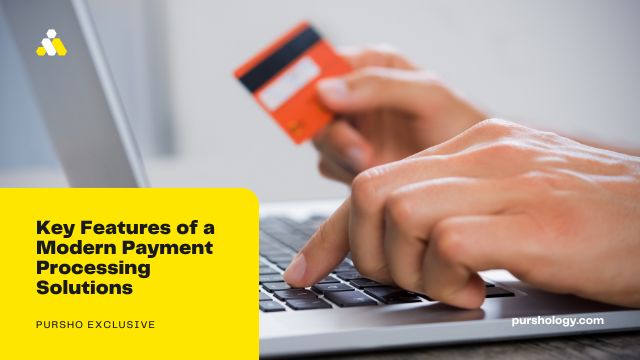At its core, a payment processing solution is the system that drives payments. It’s how your business accepts money from customers and pays suppliers, employees, and other vendors.
With digital payments gaining more and more popularity, payment processing has become a must for small and large businesses. According to Future Market Insights firm data, the global payments processing market is expected to grow at a CAGR of 9.9% to reach $231.7 billion. This post will explore some key features of modern payment processing solutions.
Customer Account Management
A modern payment processing solution should be able to manage multiple accounts, currencies, and payment methods. This is important because it allows businesses to offer their customers a wide range of payment options.
In addition, the software should also allow you to manage multiple payees. Finally, it should also support managing various users within your organization so that different employees can access different parts of the system without interfering with each other’s workflows or permissions levels.
Credit and Debit Card Payment Processing
The ability to accept credit and debit card payments is a must in today’s world. It allows you to accept payments from customers who may not have internet access or are simply unfamiliar with the online shopping experience.
Many people worldwide use credit cards as their primary payment method. Hence, it’s essential that your business can accept them. There are different types of credit cards in use around the world. American Express (AMEX), Visa, MasterCard, and Discover Card all issue their own branded cards, which are accepted by different businesses around the globe.
Credit and debit cards held the most significant share of payments from 2017 through 2021 and will remain at the top. According to Statista, 40% of the point of sale (POS) payments were made using credit cards in 2021. Debit cards were used for 30% of POS payments in 2021.
You can use advanced payment processing platforms like the one here at Stax Payments. Such platforms can help you with credit and debit card payment processing at reduced transaction costs. Using these platforms, you can save as much as 40% on payment processing.
Invoicing Tools
Invoicing tools are used to create and send invoices to customers. They can be integrated with a payment processing solution, so you don’t have to switch between applications when you want to process payments and create invoices.
Invoicing tools usually offer features such as:
- Creating, sending, and tracking invoices
- Recurring billing
- Importing data from accounting software like QuickBooks Online or Xero
The growth of digitalization has led to the growth of the e-invoice market. According to the market analysis by the Verified Market Research firm, the global e-invoice software market is all set to reach a whopping USD 7,188.8 million by 2030.
Contactless Payments
Contactless payments are a fast and convenient way to pay. When you use contactless payment solutions, you can complete the transaction in seconds by tapping or waving your card or mobile device near an NFC-enabled terminal at checkout.
Contactless payments are available on all major credit cards in the United States, including Visa and MasterCard debit/credit cards issued by US banks that support EMV (Europay, Mastercard, Visa) chip technology.
Contactless payments are also available on mobile devices such as smartphones and smartwatches with NFC chips built-in, and more than half of American consumers already own one.
Infographic created by Clover, a retail POS system company
Mobile Payments
In the modern world, it’s easier than ever to pay for goods and services using your mobile phone. Mobile payments are a convenient way to make purchases without carrying cash or credit cards around with you all day. They’re also more secure than cash since they use encryption technology that keeps your personal information safe from theft.
Mobile payment providers offer apps allowing users to pay for items at participating merchants by tapping their smartphones or tablets against special readers at checkout counters. No swiping or typing is required. This can be done in person or remotely.
Some examples include Apple Pay, Samsung Pay, and Google Wallet. These services work on most major devices, including iPhones, iPads, Macs, Android smartphones, and tablets. The number of people making mobile payments is growing, leading to the mobile wallet market growth. According to Global Market Insights, the global mobile wallet market size is expected to grow at a CAGR of 17% from 2017 to 2030.
Reporting and Analytics Support
- Real-time reporting. The ability to track sales in real time is essential for any business, and getting accurate information quickly can help you make business decisions promptly.
- Customizable reports. You want your payment processing solution to give you the ability to customize your reports, so they’re easy for you and anyone else who needs them. This will allow you to create customized reports that meet the needs of both management and staff members alike, which can be especially helpful if multiple locations are involved or if working remotely is necessary at times.
Digital Payment Security
Security is essential to any payment processing system, and the best solutions have built-in security features.
- Encryption: The data you send to or receive from your customers is encrypted using industry-standard algorithms. This ensures that it’s unreadable by anyone else who might intercept it while in transit, including hackers or malicious employees.
- Tokenization: When a card is used to make a purchase online or over the phone, it’s replaced with an anonymous token code that can’t be used for fraud purposes.
Transparent Payment Processing
Transparency in transaction processing is important because it helps you understand how much your merchant account will cost. You should be able to find out what kind of rates they charge and any other fees that might be associated with using their services. It’s also important for transparency if you can see what processing methods are available for your business and choose one that works best for you.
Another aspect of transparency when choosing a payment processor is knowing what information about your customers or business will be shared with them through their platform. This includes e-mail addresses, phone numbers, and zip codes, anything that could potentially identify someone personally should not be shared without permission from both parties involved.
Conclusion
Thank you for reading this article. We hope it helps you understand some of the key features that a modern payment processing solution should have. We also believe that by keeping these features in mind, your business will be better positioned to take advantage of the opportunities presented by new technologies like mobile payments and contactless payments.




